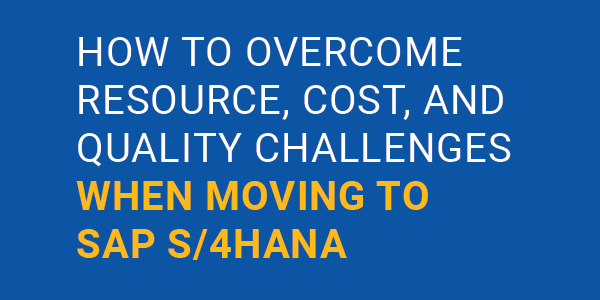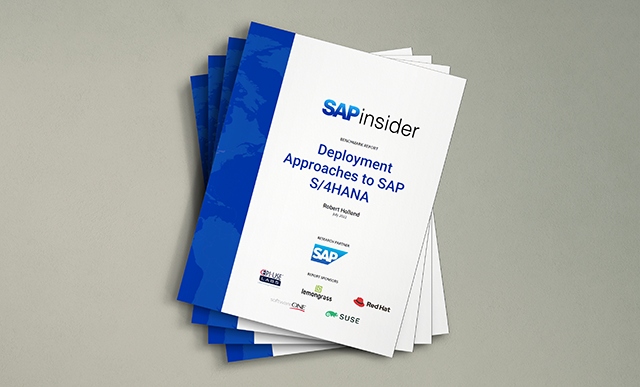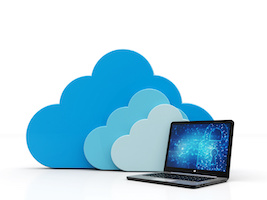Early SAP S/4HANA Adopter Shares Key Learnings During SAPinsider Keynote Session
By Annie Kennedy, Associate Conference Producer, SAPinsider
Hilti’s Head of IT Infrastructure, Christoph Baeck, launched the Your Move to SAP S/4HANA virtual event on November 17, 2020 with a keynote address, “Key Learnings from Hilti’s Move to SAP S/4HANA,” to a live audience about the learnings the Hilti team made on this journey with his team and technology partners.
Hilti, the leading supplier of tools, consumables, services and solutions for the construction industry, proved its early adopter strategy with SAP when the company kicked off the move to SAP S/4HANA back in 2017 and successfully finished the transition in November 2018. Two years later, Hilti has nearly unrivaled experience and expertise with SAP S/4HANA. Baeck presented on the impact of good partnerships and detailed test planning and execution as key factors for success. In addition, he shared some thoughts on why Hilti is running SAP S/4HANA on premise today – and where he wants to go tomorrow.
Hilti’s consolidated global back-end system is a great basis for services and our digital future, Baeck noted, with four notable steps in its timeline toward its transformation:
2001-2005: Hilti went global with data, processes, and systems based on SAP Business Suite, moving to global processing implemented at its top 25 sales organizations as well as all eight plants and its headquarters in Liechtenstein.
2006-2010: Hilti focused on leveraging, implementing another 25 sales organizations and creating shared Service Centers for finance and global logistics.
2011-2015: Balancing agility and reliability came into play, as Hilti moved to a Solid Core/Flexible Boundary architecture model, expanded mobility with smartphones and mobile applications, moved to cloud computing, and rolled out SAP Business by Design.
2016-present day: Hilti implemented a comprehensive digital strategy, defining how the company works, what it offers, and how they interact in the digital age.
Now, Baeck said proudly, the new SAP S/4HANA system and Hilti’s great employees are enablers for future digital aspirations. Hilti has centered itself in a strategy of digital customer interface, customer application software, and connected tools.
But how did they succeed in their SAP S/4HANA implementation, and what did they learn?
Baeck shared Hilti’s DRIVE initiative, an acronym for “digital, reliable, innovative, value-adding, and engaging,” for which they teamed up with SAP. DRIVE provides future differentiation potential in full alignment with the Hilti business strategy. In this program, Hilti set out to:
- Replace the core of their current global system used in all their major MOs and plants for all business transactions
- Provide cloud-based technology to drive 1:1 marketing and digital customer interaction
- In close alignment with business, provide cloud-based technologies from SAP to enable connected tools
- Build the application platform for flexible boundary applications with full integration to the SAP S/4HANA digital core
- Build a first version of future reporting capabilities with regards to performance and user experience
Hilti’s global IT team, Baeck revealed, has experienced a very busy past two years, during which time they converted gamma and delta systems and ran multiple pre-tests, tests, and re-tests that included stress, integration, regression, non-functional, and end user tests as well as training. The test scope and the number of testers, he noted, depends on the risk of the process. Unit tests ensure that all parts worked without dumps, while integration and regression tests ensure that processes worked end-to-end, while stress tests ensured that users were able to work. In DRIVE, he revealed, Hilti communicated on all levels and all channels for the entire program duration, from newsletters and communication packages to meetings and visits to trainings to dedicated websites with videos and explanations, while intensive testing by Business, IT & SAP ensured the success of this huge project.
Attendees had more than a dozen questions for Baeck, from the geographical scope to the implementation type to whether Hilti has upgrades and how those upgrades compare to the initial transition. One burning question was asked by two different people: what was Hilti’s biggest challenge in its move to SAP S/4HANA? There are always pitfalls and problems, Baeck informed the crowd; the way to overcome those challenges is to be prepared. Focus on data quality and testing, he advised. Particularly at the beginning of the transition, Hilti received monthly sizing reports with totally different results each month. When you hit memory barriers, consider them a no-go and avoid by all means. Above all, Baeck, advised, find and develop good relationships with your partners.
Hilti’s partnership with SAP and Red Hat and HPE SGI was extremely good, and he was very satisfied with their support. Partners were on site for the entire project, with top management providing support and with engineers from every vendor on site. The move to SAP S/4HANA was a big learning opportunity for them as well, Baeck noted.
Sessions for three SAPinsider virtual events will continue to run this week, November 17—19, with on-demand sessions available. Register now!
Your Move to SAP S/4HANA Virtual Summit








